Stock Market Bad Omens
Stock-Markets / Stock Markets 2013 Jul 10, 2013 - 04:33 AM GMTBy: John_Mauldin
 We have clearly been in a recent run of higher interest rates, with a looming "threat" that there might be less quantitative easing before the end of the year. It would appear now that Bernanke wants to leave his successor to implement what everyone knows must be coming at some point: a return to a normal interest-rate environment. While rising interest rates are bad for me personally (for another four months), a return to normalcy would be good for our future – though the transition is likely to be bumpy.
We have clearly been in a recent run of higher interest rates, with a looming "threat" that there might be less quantitative easing before the end of the year. It would appear now that Bernanke wants to leave his successor to implement what everyone knows must be coming at some point: a return to a normal interest-rate environment. While rising interest rates are bad for me personally (for another four months), a return to normalcy would be good for our future – though the transition is likely to be bumpy.
With this in mind, I offer this week's Outside the Box from Louis and Charles Gave. In a brief essay entitled "Bad Omens," they note:
… if the recent global equity market sell-off can be laid at the feet of the 100bp move higher in US bond yields, it is hard to know how another 50bp increase in real rates will be digested.
US investors might not have noticed, but there is carnage scattered here and there on the world's markets, and not just the equity markets. The central banks of the world, in their furious attempts to promote stability through easy-money policies, have cooked up a witches' brew of instability of unknown quantity and contents. There is no set formula for this concoction; they are making it up as they go along. Anything that seems to calm the storm momentarily becomes the order of the day. Bernanke hints at the mere possibility of less easing (not tightening, God forbid!), something that we all know must happen at some point, and the market throws up and half a dozen Fed governors go on the air to say "Not really … maybe … we are going to be cautious … we'll go slow … no one wants to do anything rash" – etc. It was almost comical.
Thus we can expect a volatile summer (as the interns man the trading desks), and I think you will find the Gaves' insights useful.
I am somewhat better, though still weak, but I'm glad to be home where I can pause and rest as necessary. I have not been down this long since I was a kid. For all those years of good health I am grateful, and I hope to go another 50 years without problems like the ones I've had this week. In the grand scheme of things, there are so many who are having to deal with so much more. I am a lucky man.
I feel I should have warned my readers about the rise in interest rates. Rates have risen since just about the day that I irrevocably committed to a large mortgage which I cannot lock in until construction is done. The interim loan rate is quite cheap, but I am made acutely aware of what rising interest rates can do to a home payment, since I must go to more conventional financing within a year. And hedge in yen.
The weather here in Texas is abnormally nice for July. Instead of the typical 100s, highs are in the low 80s, at least in the shade. If it was this way all the time, our problem would be dealing with the tax refugees from California and New England. Have a great week.
Your watching his new place begin to take shape analyst,
John Mauldin, Editor Outside the Box JohnMauldin@2000wave.comBad Omens
By Louis Gave & Charles Gave
In late May we published a debate piece on the near-term outlook for equity markets. Since then, emerging markets have once again lived up to their name by proving themselves hard to emerge from during an emergency (in USD terms, Brazil is down –35% year to date while Chinese valuations are back to 2008-crisis levels); for their part, European and US equity markets have pulled back, while the only salvation has come from Japan (the one market where it’s possible to find attractive valuations, accelerating economic activity and liquidity growth feeding off a Tour de France vitamin cocktail). But is this a case of Japan being the best looking horse in the glue factory? In the following paper, we aim to review a number of signs from equity markets that look somewhat ominous. Needless to say, we welcome any feedback on the below.
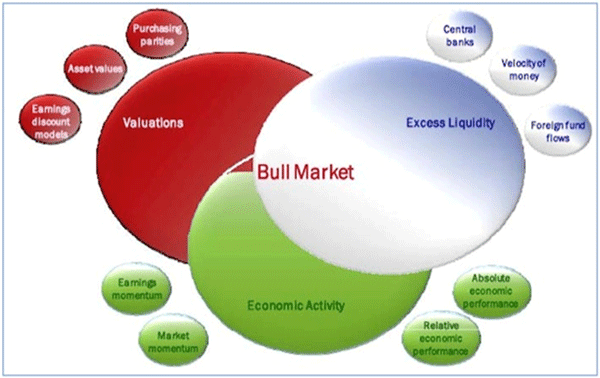
The question at hand: is this a break-out?
The chart over-leaf traces the relative performance of the S&P 500 against long-dated bonds since the Asian Crisis in 1997. Since then, the world has experienced a series of deflationary shocks, each of which has been met by more activism from the Fed and other central banks: i.e.: lower rates and higher monetary base growth. And each time, the excess money allowed for the rise in a few asset classes (TMT in the late 1990s, housing and financial intermediaries in the mid 2000s, commodities, fixed income instruments and emerging markets in the late 2000s...). But each time, the asset price rise was followed by an equity market bust; begging the question of whether the bust that seems to be unfolding in emerging markets is now the third iteration of a movie every investor has seen before (and which few have enjoyed)? Or whether the recent correlation between bonds and equities indicates that the repeated deflationary shocks are a thing of the past and nominal GDP g rowth will accelerate from now on? Could we be at a structural turning point?
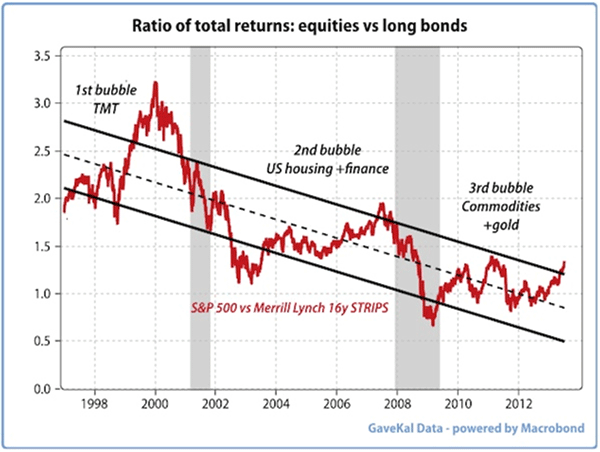
1– A first bad omen: fewer markets rising
In the chart below, we take the top twenty equity markets in the world and compile a diffusion index that shows how many rose in the previous six months, against how many fell. So when the grey bar is at +20, global equity investors have made money in every major market; when the index reads –20 they found nowhere to hide. And when the number is in negative territory, it simply means that more markets have fallen then risen in the previous six months. The red line is the performance of the S&P 500. Since 1992, we have had 14 occurrences in which more stock markets were falling than rising. In 10 of these 14 occurrences, the S&P500 fell by at least –10%. In the other 4, the S&P 500’s performance hovered between 0% and –10%. As things stand, the S&P 500 has recorded a double digit rise in the past six months, a major divergence.
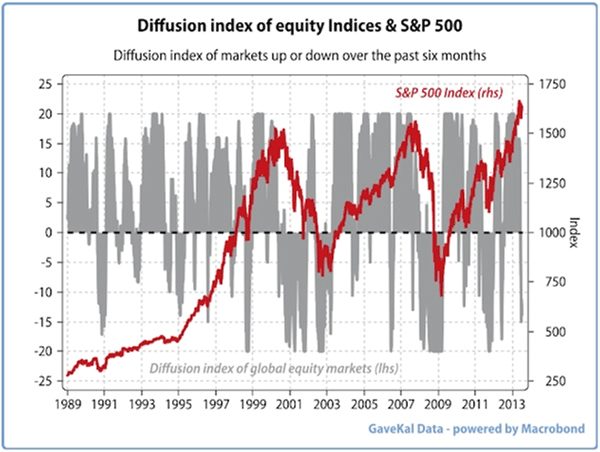
2– Another bad omen: collapsing silver prices
Unfortunately, it’s not as if, lately, equity markets have been the only place to lose money. Indeed, as every gold bug has rediscovered in recent months, precious metals have again proven that they are anything but a safe-haven. Still, drops of 30% or more in silver prices do not happen that often: looking back at the past 100 years, such drops have only occurred 11 times. And interestingly, each one of these massive declines marked a significant change in the world financial system.
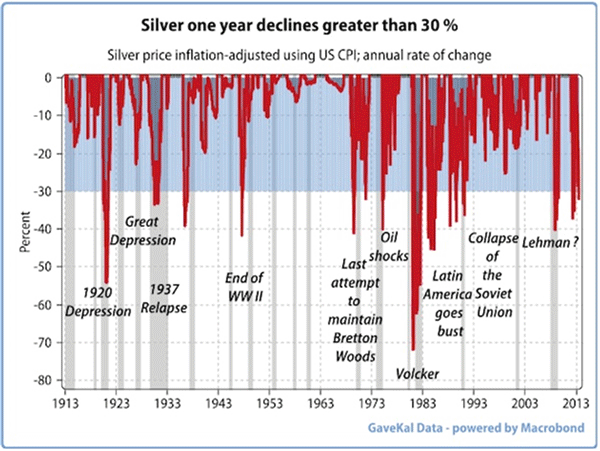
To cut a long story short, the investment rules after large declines in precious metals were almost always totally different from the rules which prevailed before the fall. More worryingly, each such decline was accompanied by a massive recession/depression somewhere in the world and almost every time by a recession in the US (grey shaded areas), the only exception being 1983-1984 when the Latin American depression did not trigger a US recession but instead a collapse in oil prices.
3– Beyond stocks and precious metals
Let us imagine a pension fund whose assets are invested conservatively with 40% in global fixed income, 40% in global equities, 10% in the world’s largest hedge funds (Bridgewater, Man-AHL, AQR...), 5% in gold and 5% in private equity. Leaving aside the private equity illiquid pocket, our pension fund will have basically lost between 5% and 15% of its assets across the board in just a few weeks.
Following these widespread losses, will our pension fund look to a) increase its risk and average down on the more beaten-up asset classes (i.e.: emerging market equities) or b) reduce its risk and use the recent rise in yield to immunize liabilities (or reduce its portfolio’s volatility)? In a world directed by VaR measures, CAPM models, and CYA boards, is that even a question?
4– Falling inflation expectations
Not that the imagined pension fund in question would automatically be wrong in increasing its fixed income allocation. After all, inflation expectations in the US (and almost everywhere) are falling like a stone, implying that fixed income instruments now offer a much higher real yield than the recent rise in nominal interest rates might imply:
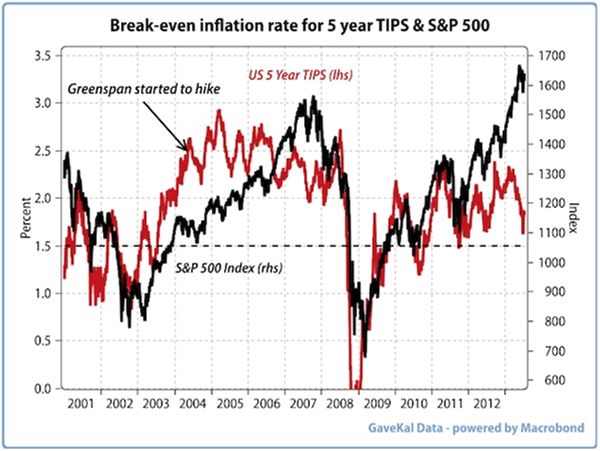
And these collapsing inflation expectations bring us to the chart above for, since the Asian Crisis, each time US inflation expectations fell below 1.5% (i.e.: a deflationary shock), US equities took a beating. That [doted] line in the sand is approaching fast. Just as worryingly, the collapse in inflation expectations, combined with the rise in nominal rates, means that the recent rise in US Baa real bond yields is the biggest one witnessed since the start of 2009—when bond markets were massively overbought.
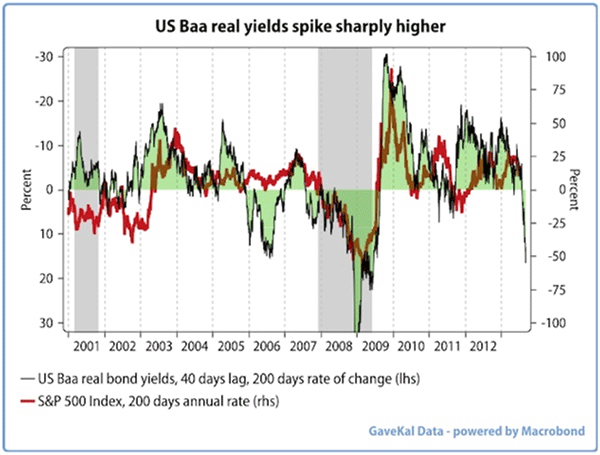
Of course, one could argue that the recent rise in yields is nothing to worry about; that it is just the side effect of the air coming out of the bond market bubble (see our Quarterly Strategy Chart Book 2Q12—The Global Bond Yield Conundrum). Unfortunately, recent weeks have shown that such an attitude may be too carefree as most assets have reacted badly to falling bond prices. Indeed, if the recent global equity market sell-off can be laid at the feet of the 100bp move higher in US bond yields, it is hard to know how another 50bp increase in real rates will be digested? Looking at the bond vs equity trade-off today, it is easy to imagine Woody Allen saying “we have reached a cross-road. One way (rising yields?) leads us to despair and annihilation, the other (falling yields?) to certain death. I hope we choose wisely.”
Conclusion
So here we are, with:
- China, the single biggest contributor to global growth over the past decade, slowing markedly.
- World trade now flirting with recession.
- OECD industrial production in negative territory YoY.
- Southern Europe showing renewed signs of political tensions (i.e.: Portugal, Greece, Italy...) as unemployment continues its relentless march higher and tax receipts continue to collapse.
- Short-term interest rates almost everywhere around the world that are unable to go any lower, even as real rates start to creep higher.
- Valuations on most equity markets that are nowhere near distressed (except perhaps for the BRICS?).
- A World MSCI that has now just dipped below its six month moving average.
- A diffusion index of global equity markets that is flashing dark amber.
- Margins in the US at record highs and likely to come under pressure, if only because of the rising dollar (most of the US margin expansion of the past decade has occurred thanks to foreign earnings—earnings that may now be challenging to sustain in the face of a weaker global trade growth and a stronger dollar).
Lackluster growth? Falling margins (outside of Japan)? Rising real rates? Unappealing valuations (outside of the BRICS)?... Perhaps these make up the wall of worry that global equities will climb successfully. After all, if the British and Irish Lions can win a rugby series in the Southern hemisphere, while a Scotsman wins Wimbledon, then nothing is impossible. Though perhaps the simpler explanation to the above growing list of bad omens was formulated by Claudius who said that “when sorrows come, they come not as single spies, but in battalions”.
John Mauldin
subscribers@MauldinEconomics.com
Outside the Box is a free weekly economic e-letter by best-selling author and renowned financial expert, John Mauldin. You can learn more and get your free subscription by visiting www.JohnMauldin.com.
Please write to johnmauldin@2000wave.com to inform us of any reproductions, including when and where copy will be reproduced. You must keep the letter intact, from introduction to disclaimers. If you would like to quote brief portions only, please reference www.JohnMauldin.com.
John Mauldin, Best-Selling author and recognized financial expert, is also editor of the free Thoughts From the Frontline that goes to over 1 million readers each week. For more information on John or his FREE weekly economic letter go to: http://www.frontlinethoughts.com/
To subscribe to John Mauldin's E-Letter please click here:http://www.frontlinethoughts.com/subscribe.asp
Copyright 2013 John Mauldin. All Rights Reserved
Note: John Mauldin is the President of Millennium Wave Advisors, LLC (MWA), which is an investment advisory firm registered with multiple states. John Mauldin is a registered representative of Millennium Wave Securities, LLC, (MWS), an FINRA registered broker-dealer. MWS is also a Commodity Pool Operator (CPO) and a Commodity Trading Advisor (CTA) registered with the CFTC, as well as an Introducing Broker (IB). Millennium Wave Investments is a dba of MWA LLC and MWS LLC. Millennium Wave Investments cooperates in the consulting on and marketing of private investment offerings with other independent firms such as Altegris Investments; Absolute Return Partners, LLP; Plexus Asset Management; Fynn Capital; and Nicola Wealth Management. Funds recommended by Mauldin may pay a portion of their fees to these independent firms, who will share 1/3 of those fees with MWS and thus with Mauldin. Any views expressed herein are provided for information purposes only and should not be construed in any way as an offer, an endorsement, or inducement to invest with any CTA, fund, or program mentioned here or elsewhere. Before seeking any advisor's services or making an investment in a fund, investors must read and examine thoroughly the respective disclosure document or offering memorandum. Since these firms and Mauldin receive fees from the funds they recommend/market, they only recommend/market products with which they have been able to negotiate fee arrangements.
Opinions expressed in these reports may change without prior notice. John Mauldin and/or the staffs at Millennium Wave Advisors, LLC and InvestorsInsight Publishing, Inc. ("InvestorsInsight") may or may not have investments in any funds cited above.
Disclaimer PAST RESULTS ARE NOT INDICATIVE OF FUTURE RESULTS. THERE IS RISK OF LOSS AS WELL AS THE OPPORTUNITY FOR GAIN WHEN INVESTING IN MANAGED FUNDS. WHEN CONSIDERING ALTERNATIVE INVESTMENTS, INCLUDING HEDGE FUNDS, YOU SHOULD CONSIDER VARIOUS RISKS INCLUDING THE FACT THAT SOME PRODUCTS: OFTEN ENGAGE IN LEVERAGING AND OTHER SPECULATIVE INVESTMENT PRACTICES THAT MAY INCREASE THE RISK OF INVESTMENT LOSS, CAN BE ILLIQUID, ARE NOT REQUIRED TO PROVIDE PERIODIC PRICING OR VALUATION INFORMATION TO INVESTORS, MAY INVOLVE COMPLEX TAX STRUCTURES AND DELAYS IN DISTRIBUTING IMPORTANT TAX INFORMATION, ARE NOT SUBJECT TO THE SAME REGULATORY REQUIREMENTS AS MUTUAL FUNDS, OFTEN CHARGE HIGH FEES, AND IN MANY CASES THE UNDERLYING INVESTMENTS ARE NOT TRANSPARENT AND ARE KNOWN ONLY TO THE INVESTMENT MANAGER.
John Mauldin Archive |
© 2005-2022 http://www.MarketOracle.co.uk - The Market Oracle is a FREE Daily Financial Markets Analysis & Forecasting online publication.



